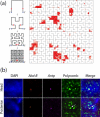A view of nuclear Polycomb bodies
- PMID: 22178420
- PMCID: PMC3329586
- DOI: 10.1016/j.gde.2011.11.004
A view of nuclear Polycomb bodies
Abstract
Polycomb group (PcG) proteins are concentrated in nuclear foci called PcG bodies. Although some of these foci are due to the tendency of PcG binding sites in the genome to occur in linear clusters, distant PcG sites can contact one another and in some cases congregate in the same PcG body when they are repressed. Experiments using transgenes containing PcG binding sites reveal that co-localization depends on the presence of insulator elements rather than of Polycomb Response Elements (PREs) and that it can occur also when the transgenes are in the active state. A model is proposed according to which insulator proteins mediate shuttling of PcG target genes between PcG bodies when repressed to transcription factories when transcriptionally active.
Copyright © 2011 Elsevier Ltd. All rights reserved.
Figures



Similar articles
-
Insulators target active genes to transcription factories and polycomb-repressed genes to polycomb bodies.PLoS Genet. 2013 Apr;9(4):e1003436. doi: 10.1371/journal.pgen.1003436. Epub 2013 Apr 18. PLoS Genet. 2013. PMID: 23637616 Free PMC article.
-
RNAi components are required for nuclear clustering of Polycomb group response elements.Cell. 2006 Mar 10;124(5):957-71. doi: 10.1016/j.cell.2006.01.036. Cell. 2006. PMID: 16530043
-
Polycomb-dependent regulatory contacts between distant Hox loci in Drosophila.Cell. 2011 Jan 21;144(2):214-26. doi: 10.1016/j.cell.2010.12.026. Cell. 2011. PMID: 21241892
-
Polycomb Recruiters Inside and Outside of the Repressed Domains.Int J Mol Sci. 2023 Jul 13;24(14):11394. doi: 10.3390/ijms241411394. Int J Mol Sci. 2023. PMID: 37511153 Free PMC article. Review.
-
Polycomb group response elements in Drosophila and vertebrates.Adv Genet. 2013;81:83-118. doi: 10.1016/B978-0-12-407677-8.00003-8. Adv Genet. 2013. PMID: 23419717 Free PMC article. Review.
Cited by
-
Htt CAG repeat expansion confers pleiotropic gains of mutant huntingtin function in chromatin regulation.Hum Mol Genet. 2015 May 1;24(9):2442-57. doi: 10.1093/hmg/ddv006. Epub 2015 Jan 8. Hum Mol Genet. 2015. PMID: 25574027 Free PMC article.
-
Nuclear organization and genome function.Annu Rev Cell Dev Biol. 2012;28:163-87. doi: 10.1146/annurev-cellbio-101011-155824. Epub 2012 Aug 17. Annu Rev Cell Dev Biol. 2012. PMID: 22905954 Free PMC article. Review.
-
Next-Generation Drugs and Probes for Chromatin Biology: From Targeted Protein Degradation to Phase Separation.Molecules. 2018 Aug 6;23(8):1958. doi: 10.3390/molecules23081958. Molecules. 2018. PMID: 30082609 Free PMC article. Review.
-
Large-scale 3D chromatin reconstruction from chromosomal contacts.BMC Genomics. 2019 Apr 4;20(Suppl 2):186. doi: 10.1186/s12864-019-5470-2. BMC Genomics. 2019. PMID: 30967119 Free PMC article.
-
Evolutionarily ancient BAH-PHD protein mediates Polycomb silencing.Proc Natl Acad Sci U S A. 2020 May 26;117(21):11614-11623. doi: 10.1073/pnas.1918776117. Epub 2020 May 11. Proc Natl Acad Sci U S A. 2020. PMID: 32393638 Free PMC article.
References
-
- Ficz G, Heintzmann R, Arndt-Jovin DJ. Polycomb group protein complexes exchange rapidly in living Drosophila. Development. 2005;132:3963–3976. - PubMed
-
- Dietzel S, Niemann H, Brückner B, Maurange D, Paro R. The nuclear distribution of Polycomb during Drosophila melanogaster development shown with a GFP fusion protein. Chromosoma. 1999;108:83–94. - PubMed
Publication types
MeSH terms
Substances
Grants and funding
LinkOut - more resources
Full Text Sources

